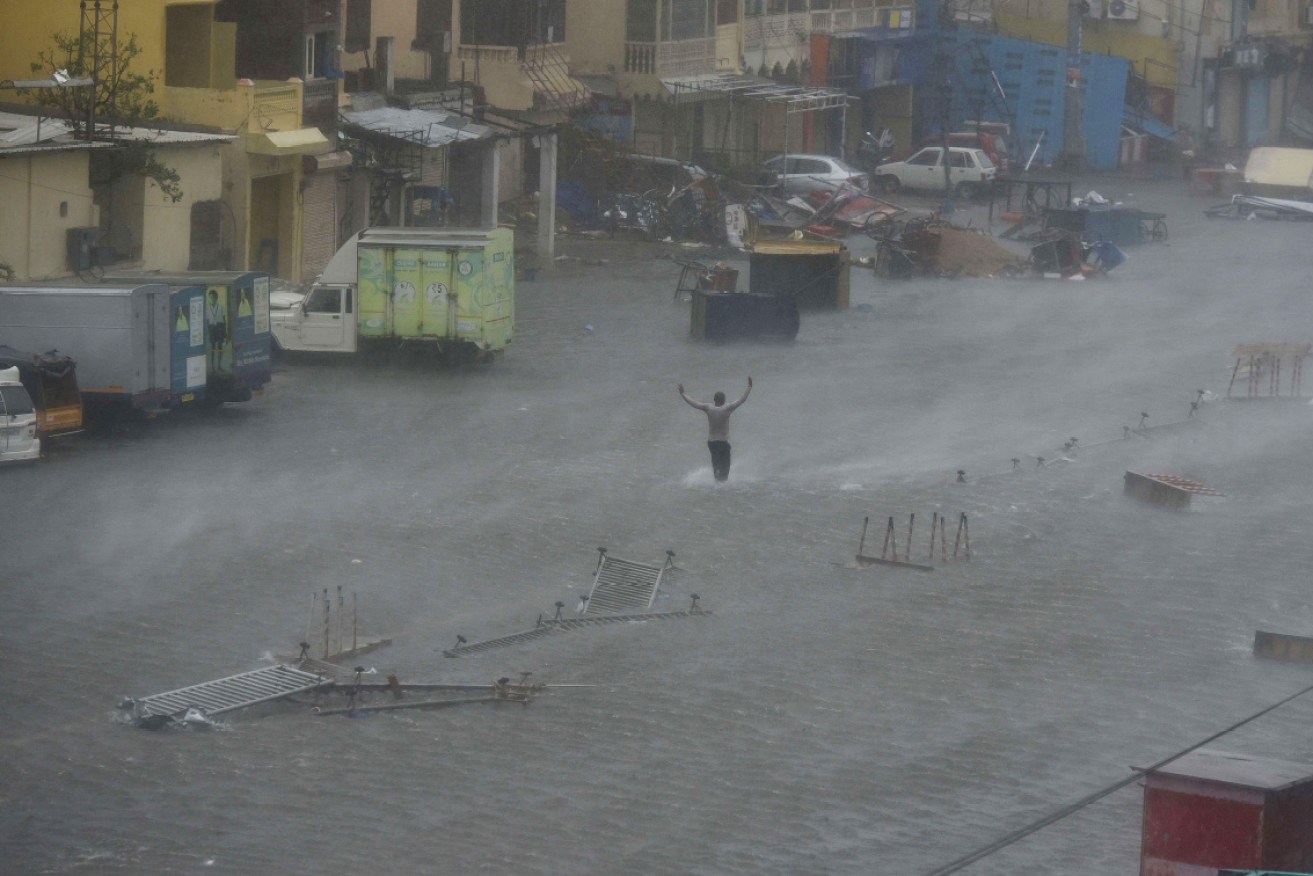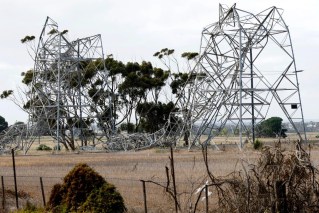Millions moved out of Cyclone Fani’s path as big blow slams India and Bangladesh


A man walks through a damaged flooded street in Puri India after Fani damaged crops, homes, businesses and the state's electricity supply. Photo: Getty
The strongest cyclone to hit India in five years has killed at least 12 people in eastern Odisha state before swinging northeast into Bangladesh, where more than a million people have been moved to safety.
Having hit land, tropical cyclone Fani lost some of its power and was downgraded to a “Deep Depression” by the Indian Meteorological Department.
A storm surge nevertheless breached embankments to submerge villages on Bangladesh’s low-lying coast, a disaster ministry official in Dhaka said.
About 1.2 million people living in the most vulnerable districts in Bangladesh had been moved to some 4000 shelters. The storm destroyed several houses in the Noakhali district, where a two-year-old child was killed and about 30 people were injured, local official Tanmoy Das told Reuters.
Crane Collapses in India Due to Cyclone Fani.
It is Believed That The Houses on Which The Crane Fell Had No Residents.
At Least Three People Have Been Killed in The Cyclone.
Stay Safe 🙏#FaniCyclone #FANI #Odisha https://t.co/yfezOJYeXh— ∼Marietta (@MariettaDaviz) May 3, 2019
In India, authorities were assessing the casualties and damage left behind by Fani, which had spent days churning slowly, building power over the northern reaches of the Bay of Bengal before tearing into Odisha.
Indian media reported at least 12 people had died across the state, with most deaths caused by falling trees, but the mass evacuation before the cyclone hit averted a greater loss of life.
At least 160 people were injured in total.
United Nations authorities praised India’s handling of the potentially catastrophic natural disaster, with the death rate much lower than had been feared.
UN special representative on disaster risk reduction Mami Mizutori Tweeted that she looked forward to hearing more at a global forum in Geneva later this month.
India's zero casualty approach to managing extreme weather events is a major contribution to the implementation of the #SendaiFramework and the reduction of loss of life from such events. I look forward to hearing more about #CycloneFani at the #GP2019Geneva May 13-17. https://t.co/AqwCwNRjxE
— Mami Mizutori (@HeadUNDRR) May 3, 2019
NDTV reported that large areas in Puri and surrounds have been submerged and thatched homes and structures destroyed.
The unprecedented evacuation operation was the largest in India’s history.
Depression is about 110 km southeast of Dhubri (Assam) & lay centered over Western Meghalaya at 1730 IST of 4th https://t.co/eT3k9Cew87 weaken into a Low Pressure area in next 12 hours.For more info kindly visit https://t.co/wRl94BRtm1 pic.twitter.com/rwqbmsZUwn
— India Meteorological Department (@Indiametdept) May 4, 2019
The Times of India reported an astonishing 10,000 villages and 52 towns were in the path of the cyclone, with road, rail and air traffic completely suspended until the cyclone passes.
Howling winds whipped and uprooted trees and driving rain impacted visibility, while streets were deserted in the state capital Bhubaneswar and Puri.
Close to 60km inland, winds brought down electricity poles in Bhubaneswar, where authorities had ordered the airport to stay closed.
https://twitter.com/Thesnehashis09/status/1124265933562736640
The seaside temple town of Puri, which lay directly in the path of Fani, suffered extensive damage, as winds gusting up to 200km/h wreaked havoc.
“Destruction is unimaginable … Puri is devastated,” Odisha Special Relief Commissioner Bishnupada Sethi told Reuters, adding that 116 people were reported injured across the state.
Footage taken from an Indian navy aircraft showed extensive inundation in areas around Puri, with wide swathes of land submerged.
At least six people died in Bhubaneswar, Odisha’s state capital, where fallen trees blocked roads and electricity supply was yet to be fully restored.
Shelters were set up in schools and other safe buildings to accommodate evacuees, including scores of tourists.
Neighbouring West Bengal state escaped substantial damage, but authorities moved nearly 45,000 people to safer locations.
The cyclone season in the Bay of Bengal can last from April to December.
Pray for Odisha🙏#Fani pic.twitter.com/O2p0i691sl
— Manorma Singh (@Manormasingh21) May 3, 2019
In 1999, a super-cyclone battered the coast of Odisha for 30 hours, killing 10,000 people. But technology advances have helped weather forecasters track cyclones more accurately and facilitate preparations.
People packed into shelters, spreading mats to wait out the storm, television and social media showed.
More than 600 pregnant women were shifted into safe locations, with nearly 500 ambulances on standby. Some 242 medical institutions had been provided with power back-up, government authorities said.
Cyclone Fani’s 240km/hr winds speeds are similar to Cyclone Larry which smashed north Queensland in 2006, causing more than half a billion dollars damage.
-with AAP








